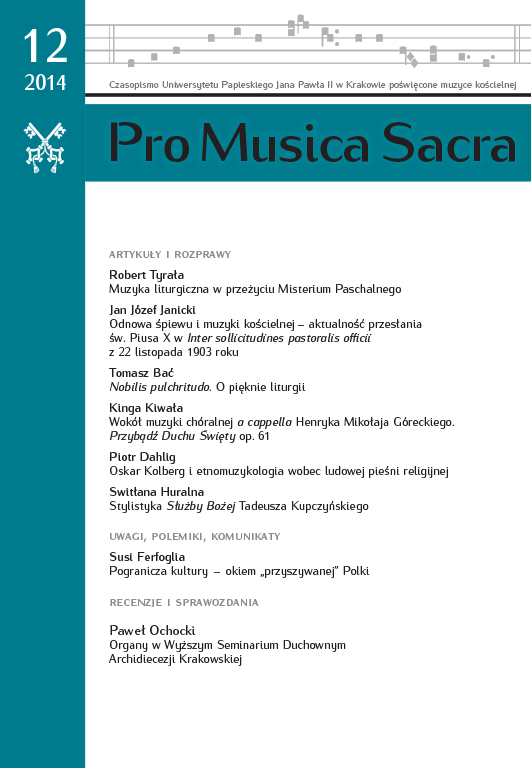Liturgical Music in Experiencing Paschal Mystery
DOI:
https://doi.org/10.15633/pms.1510Keywords:
Church music, Paschal Triduum, chants of choirs and of congregation during Triduum, the Mass of the Last Supper, Liturgy of the Lord’s Passion, the Paschal VigilAbstract
If “music is an integral part of the solemn liturgy” (SC 112) it is tremendously important that during the crucial ceremonies at churches, particularly those involving liturgical celebrations, it would become its clear sign. Since, when we prepare liturgical music we always draw our special attention to: liturgical year, namely, to a particular season, feast or celebration, examining the contents of the holy mass antiphon (referring to entrance songs and the holy communion), the mass order, the collect and the readings, especially the Gospel. And this entire content of liturgical prayers and readings is to be reflected through music of the celebrations. Therefore the music becomes integral because its role is not merely supplementary, complementary, substitutive nor decorative, but incorporated in liturgy with which it is inextricably linked. Music springs from liturgy and leads to liturgy. It enriches mass liturgy, makes it more grandly and clearly rendered.
It should be no different during the Easter Triduum for which the music ought to be even more thoroughly prepared as for the most important season of the liturgical year, that is, the Feast of Christ, suffering, crucified and resurrected. As it is the greatest event of the mystery of redemption observed here and now. The importance of the Easter Triduum was indicated by Pope Benedict XVI during his General Audience on 19 March 2008. May his words serve as the conclusion of my speech:
these three days are commonly known as ‘holy’ because they allow us to re live the event central to our Redemption. They lead to nucleus of Christian faith: the passion, Heath, and resurrection of Jesus Christ. These three days could be considered as one single day. They make up the heart and are the key to both the liturgical year and the life of the Church. … Remembering the mysteries of Christ also means a willing and complete adherence to the history of today, convinced that when we celebrate, it is vivid and present reality… These holy days reawaken a great hope in us: Christ was crucified, yet he rose again and conquered the world. Love is stronger than hate, it has triumphed and we should affiliate ourselves with this victory of love. We should therefore start again from Christ and work together with him for a world founded on peace, justice and love.References
Benedykt XVI, Udienza Generale, (19 03. 2008), www.vatican.va/holy_father/benedict_xvi/audiences/2008/documents/hf_ben-xvi_aud_20080319_it.html
Congregatio pro Culto Divino, Letterae circulares Paschalis sollemnitatis. De festis paschalibus praeparandis et celebrandi (16 I 1988), „Notitiae” 24 (1988), s. 81–107.
Kongregacja Kultu Bożego, List okólny O przygotowaniu i obchodzeniu świąt Paschalnych, tł. na j. polski: „Kielecki Przegląd Diecezjalny”, 64 (1988) 4, s. 229–243.
Nadolski B., Liturgika, t. 2, Liturgia i czas, Poznań 1991.
Downloads
Published
Issue
Section
License
The author declares that he/she owns the copyrights to the work and that they are not limited in the scope covered by this declaration, and that the work is an original work and does not violate the copyrights of others.
The author permits the Pontifical University of John Paul II in Cracow to use the work free of charge, non-exclusively and indefinitely, that is:
- to record and reproduce: produce copies of the work by printing, reprography, magnetic recording and recording with the digital technique;
- to circulate the original or copies on which the work has been recorded (to introduce into circulation, lend or hire of the original or copies, public exhibition, display as well as make the work available to the public in such a manner that everyone can have access to it in a place and at a time of their choice);
- to include the paper in a collective work;
- to grant the Creative Commons Uznanie autorstwa-Użycie niekomercyjne-Bez utworów zależnych 3.0 Poland sublicense by Pontifical University of John Paul II in Cracow
The Pontifical University of John Paul II in Cracow makes the work available on the University's Periodicals Platform owned by the University under the Creative Commons Uznanie autorstwa-Użycie niekomercyjne-Bez utworów zależnych 3.0 Polska licence. This entitles all interested parties to use the work under the following conditions:
- the author and title of the work will be presented,
- the place of publication (the title of the magazine and the URL of the original work published)will be indicated,
- the work will be distributed in a non-commercial manner,
- no derivative works will be created.

